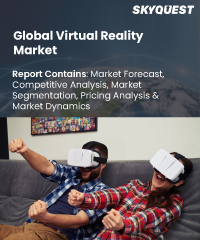
Product ID: SQMIG45J2070

Report ID:
SQMIG45J2070 |
Region:
Global |
Published Date: February, 2024
Pages:
270
|
Tables:
118 |
Figures:
83
Virtual Reality Market size was valued at USD 15.75 billion in 2019 and is poised to grow from USD 19.15 billion in 2023 to USD 91.54 billion by 2031, growing at a CAGR of 21.6% during the forecast period (2024-2031).
Virtual reality (VR) is one of the fastest-growing and most innovative areas in the global market with technology advancements and consumer adoption being the chief drivers. Last year, the market recorded shipment of 9.86 million AR and VR devices internationally which amount is expected to rise to 14.19 million units in 2019. This spike in demand highlights the fact that VR tech has become more and more mainstream in different areas and market segments. The growth of the VR sector is largely driven by the increasing number of users, which is forecasted to reach 171 million by the end of 2023. The user base is also growing in line to the expansion of VR applications not only in gaming to other areas including healthcare, education, automotive, and advertising. The trend of the Fortune 500 companies adopting VR technologies is constantly rising, with 52% already testing or applying them, which clearly indicates the ability of the technology to improve the business operations and the experience of the customers. In spite of the increasing number of VR users, issues persist, especially the motion sickness which impacts almost 58% of the users. However, future developments in VR related to hardware and software try to counter these issues making virtual reality more comfortable and satisfying for users. Furthermore, as the technology is widely adopted, consumer consciousness is growing as well, with over 50% of the U.S. population being already aware of VR devices. The VR market is noted for a big revenue, with predictions which say that virtual reality together with Augmented Reality can add more than $1.9 trillion to the world economy by 2031. The VR market earnings are diverse with the sectors involving gaming, healthcare, advertising, automotive and real estate. Among as the virtual reality gaming market, which is projected to experience exponentially growth as VR gaming platforms like Sony's PS VR gained over 5 million sales around the globe.
On the other side, the healthcare sector is expected to record the highest compounding annual growth rate between forecasted period due to the fact that VR exhibits the highest potential for medical education, therapy, and patient care. The launch of individual VR headsets denotes a significant breakthrough that has since revolutionized the VR industry. IDC predicts that VR headsets will hold the leading position by the end of 2025 as stand-alone devices become most popular among consumers due to their smaller size, portability and independence. Such transition is provided by the factors that drive consumer desire and trigger industry inventiveness.
US Virtual Reality Market is poised to grow at a sustainable CAGR for the next forecast year.
Our industry expert will work with you to provide you with customized data in a short amount of time.
REQUEST FREE CUSTOMIZATIONVirtual Reality Market size was valued at USD 15.75 billion in 2019 and is poised to grow from USD 19.15 billion in 2023 to USD 91.54 billion by 2031, growing at a CAGR of 21.6% during the forecast period (2024-2031).
Want to customize this report? This report can be personalized according to your needs. Our analysts and industry experts will work directly with you to understand your requirements and provide you with customized data in a short amount of time. We offer $1000 worth of FREE customization at the time of purchase.

Product ID: SQMIG45J2070